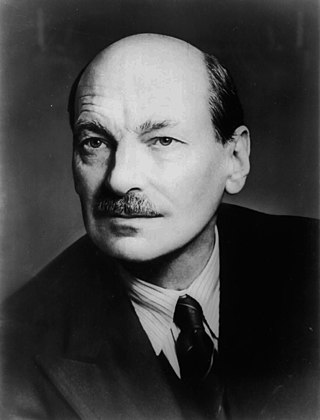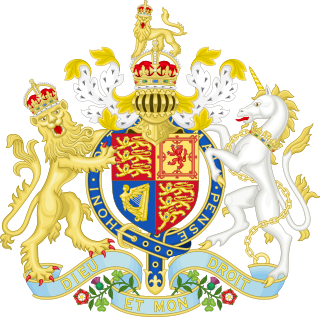
Clement Richard Attlee, 1st Earl Attlee,, was a British statesman and Labour Party politician who was Prime Minister of the United Kingdom from 1945 to 1951 and Leader of the Labour Party from 1935 to 1955. Attlee was Deputy Prime Minister during the wartime coalition government under Winston Churchill, and Leader of the Opposition on three occasions: from 1935 to 1940, briefly in 1945 and from 1951 to 1955. He remains the longest serving Labour leader.
The Central Electricity Generating Board (CEGB) was responsible for electricity generation, transmission and bulk sales in England and Wales from 1958 until privatisation of the electricity industry in the 1990s.
Coal gas is a flammable gaseous fuel made from coal and supplied to the user via a piped distribution system. It is produced when coal is heated strongly in the absence of air. Town gas is a more general term referring to manufactured gaseous fuels produced for sale to consumers and municipalities.
The British Transport Commission (BTC) was created by Clement Attlee's post-war Labour government as a part of its nationalisation programme, to oversee railways, canals and road freight transport in Great Britain. Its general duty under the Transport Act 1947 was to provide an efficient, adequate, economical and properly integrated system of public inland transport and port facilities within Great Britain for passengers and goods, excluding transport by air.

The Transport Act 1962 is an Act of the Parliament of the United Kingdom. Described as the "most momentous piece of legislation in the field of railway law to have been enacted since the Railway and Canal Traffic Act 1854", it was passed by Harold Macmillan's Conservative government to dissolve the British Transport Commission (BTC), which had been established by Clement Attlee's Labour government in 1947 to oversee railways, canals and road freight transport. The Act established the British Railways Board, which took over the BTC's railway responsibilities from 1 January 1963 until the passing of the Railways Act 1993.

The Transport Act 1947 was an Act of the Parliament of the United Kingdom. Under the terms of the Act, the railway network, long-distance road haulage and various other types of transport were nationalised and came under the administration of the British Transport Commission. The BTC was responsible to the Ministry of Transport for general transport policy, which it exercised principally through financial control of a number of executives set up to manage specified sections of the industry under schemes of delegation.

The National Coal Board (NCB) was the statutory corporation created to run the nationalised coal mining industry in the United Kingdom. Set up under the Coal Industry Nationalisation Act 1946, it took over the United Kingdom's collieries on "vesting day", 1 January 1947. In 1987, the NCB was renamed the British Coal Corporation, and its assets were subsequently privatised.
The British Electricity Authority (BEA) was established as the central British electricity authority in 1948 under the nationalisation of Great Britain's electricity supply industry enacted by the Electricity Act 1947. The BEA was responsible for the generation, transmission and sale of electricity to area electricity boards, and the development and maintenance of an efficient, coordinated and economical system of electricity supply.
The United Kingdom Central Electricity Board (CEB) was established by the Electricity (Supply) Act 1926. It had the duty to supply electricity to authorised electricity undertakers, to determine which power stations would be 'selected' stations to generate electricity for the board, to provide main transmission lines to interconnect selected stations and electricity undertakers, and to standardise generating frequency.

Clement Attlee was invited by King George VI to form the Attlee ministry in the United Kingdom in July 1945, succeeding Winston Churchill as Prime Minister of the United Kingdom. The Labour Party had won a landslide victory at the 1945 general election, and went on to enact policies of what became known as the post-war consensus, including the establishment of the welfare state and the nationalisation of 20 percent of the entire economy. The government's spell in office was marked by post-war austerity measures; the crushing of pro-independence and communist movements in Malaya; the grant of independence to India, Pakistan, Ceylon, and Burma; the engagement in the Cold War against Soviet Communism; and the creation of the country's National Health Service (NHS).

The Electricity Act 1947 was an act of the Parliament of the United Kingdom which nationalised, or bought into state control, the electricity supply industry in Great Britain. It established a central authority called the British Electricity Authority (BEA) to own and operate all public electricity generation and transmission facilities and created 14 area electricity boards with a duty to acquire bulk supplies of electricity from the central authority and to distribute and sell electricity economically and efficiently to industrial, commercial and domestic consumers. It vested 505 separate local authority and company owned electricity undertakings in the BEA with effect from 1 April 1948. The Electricity Act 1947 is one of a number of acts promulgated by the post-war Labour government to nationalise elements of the UK’s industrial infrastructure; other acts include the Coal Industry Nationalisation Act 1946; Transport Act 1947 ; Gas Act 1948; and Iron and Steel Act 1949.

The North Thames Gas Board was an autonomous state-owned utility area gas board providing gas for light and heat to industries, commercial premises and homes in south-east England. The board's area of supply, encompassing 1,059 square miles (2,740 km2), included parts of the County of London, Berkshire, Buckinghamshire, Essex, Hertfordshire, Middlesex and Surrey.

British Gas is an energy and home services provider in the United Kingdom. It is the trading name of British Gas Services Limited and British Gas New Heating Limited, both subsidiaries of Centrica. Serving around ten million homes in the United Kingdom, British Gas was the largest energy supplier in the country until 2024 when it was overtaken by Octopus Energy. It remains the largest gas supplier. It is considered one of the Big Six dominating the gas and electricity market in the United Kingdom.

The Electricity Act 1957 was an Act of Parliament of the United Kingdom. The principal impact of the Act was the dissolution of the Central Electricity Authority, which it replaced with the Central Electricity Generating Board (CEGB) and the Electricity Council.
The Coal Commission was a United Kingdom government agency, created to own and manage coal reserves. It was set up in 1938 and ceased to operate on 1 January 1947.

The Gas Act 1948 was an Act of the Parliament of the United Kingdom which nationalised, or bought into state control, the gas making and supply industry in Great Britain. It established 12 area gas boards to own and operate all public gas-making, distribution and sales facilities and created a central authority: the Gas Council. It vested the existing local authority and company-owned gas undertakings into the area boards with effect from 1 May 1949. The Gas Act 1948 was one of a number of Acts promulgated by the post-war Labour government to nationalise elements of the UK's industrial infrastructure; other Acts include the Coal Industry Nationalisation Act 1946; the Electricity Act 1947; Transport Act 1947 ; and the Iron and Steel Act 1949.

The Gas Act 1972 was an act of the Parliament of the United Kingdom which restructured the British gas industry. It established the British Gas Corporation to exercise full responsibility for the oversight, control and operation of the gas industry. The twelve autonomous area gas boards which had managed the industry in their areas now became regions of the British Gas Corporation. The Gas Council, also established under the Gas Act 1948, was abolished and the Gas Act 1948 was repealed. The provisions of the Act came into force on 1 January 1973.
The Gas Council was a UK government body that provided strategic oversight of the gas industry in England, Wales and Scotland between 1949 and 1972.

The Iron and Steel Act 1949 was an act of the Parliament of the United Kingdom which nationalised, or bought into state control, elements of the iron and steel industry in Great Britain. It established an Iron and Steel Corporation which acquired certain iron and steel companies. In a departure from earlier nationalisations the Corporation only acquired the share capital of the companies, not the undertakings themselves. The individual companies continued to operate under management Boards appointed by the corporation. The Iron and Steel Act 1949 was one of a number of acts promulgated by the post-war Labour government to nationalise elements of the UK's industrial infrastructure; other acts include the Coal Industry Nationalisation Act 1946; the Electricity Act 1947; Transport Act 1947 ; and the Gas Act 1948.

The Gas Act 1965 is an Act of the Parliament of the United Kingdom which extended the powers of the Gas Council to buy, make or supply gas; it authorised and controlled the underground storage of gas; and permitted the sale of industrial gas for non-fuel purposes. The Act was in response to changing technologies that had developed since the gas industry was nationalised in 1949.






